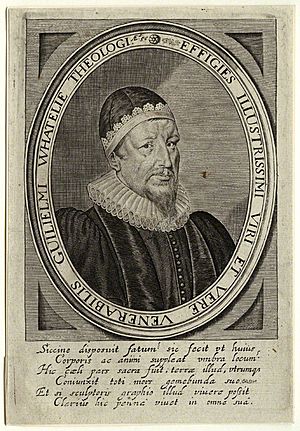William Whately facts for kids
William Whately (born 1583, died 1639) was an English Puritan minister and writer. He was known for his strong religious beliefs and his sermons.
Contents
William Whately's Early Life and Education
William Whately was born in Banbury, Oxfordshire, on May 21, 1583. His father, Thomas Whately, was the mayor of Banbury twice.
When he was 14, William went to Christ's College, Cambridge. He studied there and earned his first degree in 1601. He was known for being good at logic and public speaking.
After Cambridge, Whately continued to study religion at home. He had strong Puritan beliefs. Puritans were a group of Protestants who wanted to make the Church of England simpler. They believed in strict moral rules.
He later went to St. Edmund Hall in Oxford to prepare to become a minister. He earned another degree in 1604.
Becoming a Minister
Soon after his studies, William Whately became a lecturer in Banbury. In 1610, he became the vicar (a type of minister) of Banbury. People from Oxford would even travel to Banbury to hear him preach. He also gave talks with other ministers in Stratford-on-Avon.
Whately passed away in Banbury on May 10, 1639. He was buried in the churchyard. He was very popular in Banbury during his life.
Whately's Writings
William Whately wrote many books and sermons. One of his most famous books was A Bride-Bvsh; or a Direction for Married Persons. This book was about the duties of married people.
He faced some trouble because of this book. He had to explain his views to a special court called the Court of High Commission. He later said he had made a mistake in some of his ideas. He explained this in a later edition of the book and in another work called A Care Cloth.
Here are some of the other books Whately wrote:
- The Redemption of Time, published in 1606.
- A Caveat for the Covetous, published in 1609.
- The New Birth, published in 1618.
- God's Husbandry, published in 1622.
- A Pithie, Short, and Methodicall opening of the Ten Commandements, published in 1622.
- Mortification, published in 1623.
- Charitable Teares, published in 1623.
- A Care-Cloth; or a Treatise of the Cvmbers and Troubles of Marriage, published in 1624.
- Sinne no more, published in 1628. This was a sermon he gave after a big fire destroyed most of Banbury.
- The Poore Man's Advocate, published in 1637.
- The Oyle of Gladness, or Comfort for Dejected Sinners, published in 1637.
- Prototypes, published in 1640 after he had died.
Whately's Family
William Whately married Martha Hunt. Her father, George Hunt, was a minister at Magdalen College, Oxford. George Hunt's father, John Hunt, was a Protestant who was almost executed during the reign of Queen Mary.
William and Martha Whately had two sons:
- William (died 1647), who might have been the William Whately who became mayor of Banbury.
- Thomas, who became a minister in Sutton-under-Brailes. He later preached in other towns like Milton and Woodstock. He was buried in Banbury in 1698.


